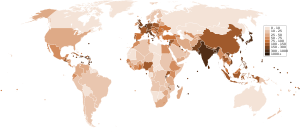
World Population Day
Encyclopedia

Population
A population is all the organisms that both belong to the same group or species and live in the same geographical area. The area that is used to define a sexual population is such that inter-breeding is possible between any pair within the area and more probable than cross-breeding with individuals...
issues. The event was established by the Governing Council of the United Nations Development Programme
United Nations Development Programme
The United Nations Development Programme is the United Nations' global development network. It advocates for change and connects countries to knowledge, experience and resources to help people build a better life. UNDP operates in 177 countries, working with nations on their own solutions to...
in 1989. It was inspired by the public interest in Five Billion Day on July 11, 1987, approximately the date on which the world's population reached five billion people.
The world population on the 20th anniversary of Five Billion Day, July 11, 2007, was estimated to have been 6,727,551,263.
See also
- Agricultural effects and population limits from peak oil
- List of most highly populated countries
- Negative Population GrowthNegative Population GrowthNegative Population Growth is a membership organization in the United States, founded in 1972.NPG works on overpopulation issues and advocates a gradual reduction in U.S. and world population. NPG believes the optimal population for the United States is 150 to 200 million and that the optimal...
- Over-consumptionOver-consumptionOver-consumption is a situation where resource-use has outpaced the sustainable capacity of the ecosystem. A prolonged pattern of overconsumption leads to inevitable environmental degradation and the eventual loss of resource bases...
- OverpopulationOverpopulationOverpopulation is a condition where an organism's numbers exceed the carrying capacity of its habitat. The term often refers to the relationship between the human population and its environment, the Earth...
- SustainabilitySustainabilitySustainability is the capacity to endure. For humans, sustainability is the long-term maintenance of well being, which has environmental, economic, and social dimensions, and encompasses the concept of union, an interdependent relationship and mutual responsible position with all living and non...
- The Limits to Growth
- The Revenge of GaiaThe Revenge of GaiaThe Revenge of Gaia: Why the Earth is Fighting Back – and How we Can Still Save Humanity is a book by James Lovelock.- External links :* The Revenge of Gaia * , edited extract from The Guardian, 24 March 2006...
- United Nations Population FundUnited Nations Population FundThe United Nations Population Fund is a UN organization. The work of the UNFPA involves promotion of the right of every woman, man and child to enjoy a life of health and equal opportunity. This is done through major national and demographic surveys and with population censuses...

